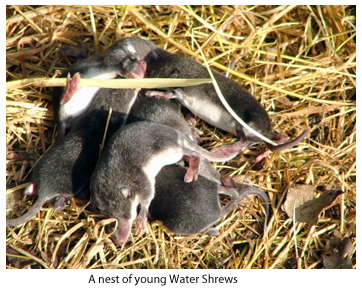Water Shrews in Essex - Healthy Life Essex
Home » Articles » Outdoor Life » Wildlife » Mammals » Water Shrews in Essex
Water Shrews in Essex
The water shrew Neomys fodiens is one of our county’s most intriguing riparian (river bank dwelling) species.
It is the largest of Britain’s shrew species, reaching lengths of 11-17cm from nose to tail and weighing 12-18g. They are distinguishable from other shrew species by the dense, black, velvety fur on their back and pale grey/white fur on their underside. They have a fringe of silvery-white hairs along the tail and on the hind feet, forming a ‘keel’ to aid swimming. Like all shrews they have an elongated snout, with small ears and tiny eyes.

The water shrew is a semi-aquatic species and is therefore most often found in habitats close to water, including banks of streams, rivers and ponds, as well as reedbeds and fens. Occasionally individuals are found far from water in habitats such as rough grasslands, woodland and hedgerows. In 2009 Writtle College lecturers reported the identification of water shrew in a hedgerow during a small mammal trapping workshop in the middle of an arable field, approximately 300m from the nearest water course. These recordings are most likely to be dispersing juveniles searching for new territories.
Despite the endearing charm of the water shrew, it has been largely ignored in comparison to other river dwelling mammals, therefore very little is known about its distribution and population status in Essex. Its elusive nature and discreet field signs make it very difficult to study, though efforts have been made in the past.
The Mammal Society’s national Water Shrew Survey in 2004–2005 turned out some interesting results, finding water shrews at 17.4% of sites surveyed. They were widely distributed from the northern Scotland to southern England, with a concentration in central and eastern England. This recognition that eastern counties, such as Essex, are favoured by water shrews, suggests a countywide survey is a valuable opportunity to update our records.
The Water for Wildlife Officer at the Essex Wildlife Trust is currently implementing plans to launch a countywide survey, the first of its kind in Essex. The survey will use the ‘bait tube’ method, which is cheap and effective in determining the presence of water shrews at a site. Lengths of plastic tube (4cm diameter) are covered at one end (with mesh material), baited with casters and placed 2-3m from the waters edge. The water shrews are free to enter and leave the tube at will. As they linger to explore and feed they will deposit droppings (scats) which are then collected and analysed. The content of the scats indicates the presence of different small mammals. Sites positive for the presence of water shrew relies on accurate identification of fragments of freshwater invertebrates (main diet) within the scats; therefore the survey is likely to be most effective in aquatic habitats. If the scats are whole they can often be identified by eye, distinguished by their large size (7mm x 2mm) and shards of grey/white ‘shell’ of freshwater crustaceans.
Any other field signs can be noted at the time of the survey, including footprints, feeding signs (small broken shells) and burrows, although water shrews will often use disused burrows of voles and mice, making positive identification difficult without other definite field signs. Notes regarding the habitat can be made at the chosen survey sites (habitat type, water depth, vegetation type) which, in conjunction with positive scat identification will provide valuable information about the population status and the preferred habitat of this intriguing little mammal in Essex.
BECOME A SURVEY VOLUNTEER
If you would like to help out with the water shrew survey and become one of our volunteers, please contact Darren Tansley, Water for Wildlife Officer at the Trust. Volunteers are required for both carrying out the surveys and analysing the contents of the survey tubes. Emaildarrent@essexwt.org.uk or tel 01621 862995
Joanne Vere
Conservation Volunteer – Essex Wildlife Trust
Water for wildlife is a unique partnership of the Wildlife Trusts, working with the water companies, Environment Agency and other key partners to provide a more consistent and targeted approach to wetland conservation across the UK.


Picture Credits
“A nest of young water shrews ” by Rob Parry

